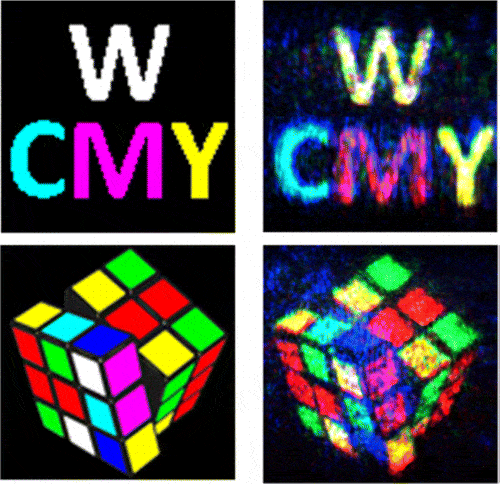Using nanomaterials whose tiny surface was etched with various geometrical patterns, researchers at Missouri University of Science and Technology demonstrated the first full-color 3-D holograms with such an approach. Their work could lead to anything from colorful 3D holograms projected from the smartphones of the future or better, more secure credit card holograms.

Demonstration of the nanomaterial holographic generator which is supposed to advance various holographic applications, according to the researchers. Credit: ACS Nano
The new method used involves ultrathin nanometer-scale metallic films with metasurfaces that can be used to manipulate light’s wavefront. The metasurface hologram developed by the team consists of an aluminum film 35 nanometers thick, perforated with tiny rectangular holes 80 nanometers high by 160 nanometers wide. A microfabrication process known as focused ion beam milling was used to create different orientation angles.
To make holograms you have to manipulate the light’s wavefront. Dr. Xiaodong Yang and Dr. Jie Gao, both assistant professors at Missouri S&T, used ultrathin metal films with variable metasurfaces. Just so you can get an idea of the scale involved, the team metal films were only 35 nanometers thick whereas the typical human hair is 100,000 nanometers wide. That’s only 10 times thicker than the diameter of DNA.
Using ion beam milling, the researchers then made tiny rectangular holes of 160 by 80 nanometers into the metasurface with various orientation angles. It was then only a matter of firing three different lasers (red, green blue) onto the metasurface to create “clean and vivid full-color holographic images with high resolution and low noise.”
By varying the intensity of each laser, the researchers produced the primary colors — red, green and blue — as well as the secondary colors known as cyan, magenta, yellow and white. Mixing these colors offers virtually the whole spectrum.
To demonstrate their work, the letters C, M, Y and W, a Rubik’ cube and an apple were projected as 3-D holograms.
“By adjusting the orientation angle of the nanoscale slits, we are able to fully tune the phase delay through the slit for realizing the phase modulation within the entire visible color range,” says Yang. “In addition, the amplitude modulation is achieved by simply including or not including the slit. Our holograms contain both amplitude and phase modulations at nanometer scale so that high resolution and low noise holographic images can be reconstructed.”
Previous methods produced 3-D holograms in a limited color spectrum, but the new work can reconstruct almost all visible colors.
Findings appeared in ACS Nano.









